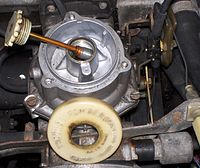Dashpot
This articleneeds additional citations forverification.(November 2023) |

of linear dashpot
Adashpot,also known as adamper[citation needed],is a mechanical device that resists motion via viscousfriction.[1]The resulting force is proportional to thevelocity,but acts in the opposite direction,[2]slowing the motion and absorbing energy. It is commonly used in conjunction with aspring.Theprocess and instrumentation diagram(P&ID) symbol for a dashpot is![]() .
.
Types[edit]
The two most common types of dashpots are linear and rotary.
Linear damper[edit]
Linear dashpots — or linear dampers — are used to exert a force opposite to a translation movement. They are generally specified by stroke (amount of linear displacement) and damping coefficient (force per velocity).
Rotary damper[edit]
Similarly, rotary dampers will tend to oppose any torque applied to them, in an amount proportional to their rotational speed. Their damping coefficients will usually be specified by torque per angular velocity. One can distinguish two kinds of viscous rotary dashpots:[3]
- Vane dashpotswhich have a limited angular range but provide a significant damping torque. The damping force is the result of one or multiple vanes moving through a viscous fluid and letting it flow via calibrated openings.
- Continuous rotation dashpotswhich aren't limited in their rotation angle but provide a smaller damping coefficient. These use the friction generated by the shearing forces induced in the viscous fluid itself by the difference in motion between the dashpot's rotor and stator.
Eddy current damper[edit]
A less common type of dashpot is aneddy currentdamper, which uses a large magnet inside a tube constructed of a non-magnetic but conducting material (such asaluminiumorcopper). Like a common viscous damper, the eddy current damper produces a resistive force proportional to velocity. A common use of the eddy current damper is in balance scales. This is a frictionless method that allows the scale to quickly come to rest.[4][5][6][7]
One-way operation[edit]
Dashpots frequently use a one-way mechanical bypass to permit fast unrestricted motion in one direction and slow motion using the dashpot in the opposite direction. This permits, for example, a door to be opened quickly without added resistance, but then to close slowly using the dashpot. For hydraulic dashpots this unrestricted motion is accomplished using a one-way check-valve that allows fluid to bypass the dashpot fluid constriction. Non-hydraulic rotatory dashpots may use a ratcheting gear to permit free motion in one direction.
Applications[edit]

A dashpot is a common component in adoor closerto prevent it from slamming shut. A spring applies force to close the door, which the dashpot offsets by forcing fluid to flow through an orifice, often adjustable, between reservoirs, which slows the motion of the door.
Consumer electronicsoften use dashpots where it is undesirable for a media access door or control panel to suddenly pop open when the door latch is released. The dashpot provides a steady, gentle motion until the access door has fully opened.
Dashpots are commonly used in dampers andshock absorbers.The hydraulic cylinder in an automobile shock absorber is a dashpot. They are also used oncarburetors,where the return of the throttle lever is cushioned just before the throttle fully closes, then is allowed to fully close slowly to reduce emissions. The BritishSU carburettor's main piston carries a stepped needle. This needle is held in the fuel flow orifice. Themanifold vacuumcauses this piston to rise allowing more fuel into the airflow. The SU's dashpot has a fixed hydraulic piston, damping the main piston as it moves upward. A valve in the piston disables the damping as the main piston returns.
Large forces and high speeds can be controlled by dashpots. For example, they are used to arrest thesteam catapultsonaircraft carrierdecks.
Relayscan be made to have a long delay by utilizing a piston filled with fluid that is allowed to escape slowly. Electricalswitchgearmay use dashpots in theirovercurrentsensing mechanism to reduce reaction speed to brief events, thus making them less sensitive to false-triggering during transients whilst still remaining sensitive to sustained overloads. Another use is for delaying the closing or opening of an electrical circuit. Such adashpot timermight be used for example for timed staircase lighting.
Anti-stallmechanisms in internal combustion engines are aimed to prevent stalling of the engine at low rpm. Anti-stall mechanisms use dashpots to arrest the final closing movement of the throttle.
Viscoelasticity[edit]

Dashpots are used asmodelsofmaterialsthat exhibitviscoelasticbehavior, such as muscle tissue.MaxwellandKelvin–Voigtmodels ofviscoelasticityuse springs and dashpots inseries and parallel circuitsrespectively. Models containing dashpots add a viscous, time-dependent element to the behavior of solids, allowing complex behaviors likecreepand stress relaxation to be modeled.
See also[edit]
References[edit]
- ^Oxford English Dictionary.Oxford University Press.
dash-pot,n.a contrivance for producing gradual descent in a piece of mechanism or for preventing vibration or sudden motion, consisting of a cylinder or chamber containing liquid in which a piston moves; a hydraulic buffer.
- ^Mark H. Holmes (2009).Introduction to the Foundations of Applied Mathematics.Springer. p. 329.
the resistance force is proportional to the velocity
- ^"Dashpot Types".www.kinetrol.com.Archived fromthe originalon 6 December 2021.Retrieved5 August2020.
- ^Mike Plissi."Update on eddy-current damping experiments"(PDF).Laser Interferometer Gravitational-Wave Observatory (LIGO). Archived fromthe original(PDF)on 2010-07-25.Retrieved2010-05-29.
A magnet moving inside a non-magnetic conductive tube has its motion retarded. Retardation force is proportional to velocity of magnet- viscous damping.
- ^Sodano; Bae; Inman; Belvin (June 2006)."Improved Concept and Model of Eddy Current Damper"(PDF).Transactions of the ASME.128:294–302. Archived fromthe original(PDF)on 2010-07-28.
This process of the generation and dissipation of eddy current causes the system to function as a viscous damper
- ^Starin; Neumeister (19–21 September 2001). "Eddy Current Damping Simulation and Modeling".Proceedings of the 9th European Space Mechanisms and Tribology Symposium.480:321–326.Bibcode:2001ESASP.480..321S.ISBN92-9092-761-5.
One major advantage of ECD's is their linearity
- ^Henry A. Sodano (May 5, 2005)."Development of Novel Eddy Current Dampers for the Suppression of Structural Vibrations"(pdf).Virginia Polytechnic Institute and State University.hdl:10919/27677.Retrieved2020-09-26.
This damping force can be described as a viscous force due to the dependence on the velocity of the conductor.
